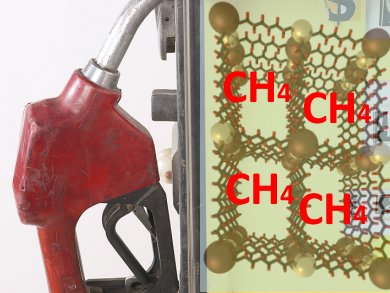Promises and Shortcoming of MOFs for Methane Storage
Finding a safe way to store energetic gases without recourse to high-pressure storage vessels will be critical to the future success and safety of “clean” energy technologies that use hydrogen and methane generated from sustainable resources. One solution to this problem involves the development of inexpensive, low-density, and highly porous materials within which large volumes of said gas might be adsorbed at moderate pressures and quickly released. The ideal material would be capable of trapping as much gas as can be stored compressed in the same volume and released as easily as opening a valve.
Commercially available, porous materials such as activated carbon have insufficient capacity for methane and while many research teams have expended great efforts over the last few years searching for the ideal gas storage substance none has yet emerged as a significant leader. Metal-organic frameworks (MOFs) have, nevertheless, become the focus of much research as they are essentially synthetic, designer minerals that can, to some extent, be tailored to have particular pore sizes and affinities for specific gases.
There have been many MOFs offered up as methane storage materials but they often have technical shortcomings, not least an inability to release sufficient quantities of adsorbed gas at a suitable rate. In addition, the synthesis of such experimental MOFs has not so far been amenable to scale-up beyond the small quantities used at the laboratory bench. Commercial materials must therefore fulfill numerous technical criteria if they are to offer a tenable alternative to pressurized gas cylinders.
High Capacity MOF Suitable for Scale-Up
Omar Farha and colleagues at Northwestern University in Evanston, Illinois, USA, have developed a novel MOF, which they say can be produced efficiently in gram quantities, that can adsorb almost as much methane gas as can be stored in pressurized tanks. But, the MOF, which they call NU-125, requires just 58 atmospheres of pressure at room temperatures as opposed to the 245 atm required to compress methane. The MOF can be cycled repeatedly to adsorb and desorb methane gas.
The material they say thus represents a potentially viable storage medium for “gas” powered cars or for fuel cell feedstock tanks. Storage efficiency is an impressive 86 % of that possible in pressurized tanks. This is especially important, given that most methane-powered vehicles require cylinders at 245 atm to provide sufficient fuel so that the vehicle range is not too short. For cylinders, lower pressure means less methane, which means less distance between fuel stops. The team also points out that the use of a storage tank filled with a MOF rather than a pressurized cylinder will reduce the safety infrastructure that would need to be implemented to allow drivers to refuel as necessary.
Farha’s team at Northwestern and their colleagues at the National Institute of Standards and Technology, Gaithersburg, USA, led by Taner Yildirim, describe details of their offering – NU-125 – in a forthcoming issue of the journal Energy & Environmental Science. The researchers describe the synthesis of this MOF from a copper(II) salt and a new hexa-carboxylic acid linker molecule. This bulky organic molecule acts as a ligand for the copper ions, connecting them in the framework but holding them quite wide apart to generate a highly porous solid with a large internal surface area once the material is crystallized. The team says the product is available in high yield, at gram quantities and is “robust”. Powder X-ray diffraction experiments confirm the reproducibility of their synthesis and crystallization, the team says.
MOF pioneer Mohamed Eddaoudi of the King Abdullah University of Science and Technology in Saudi Arabia recognizes the enormous potential in this area. “I am not surprised that MOFs can store this large amount of methane at relatively reduced pressure, compared with compressed gas cylinders, and it is just a matter of time before the right combination of pore size and surface functionality is found.” He adds that, “The great advantage of MOFs is that you can correlate their properties to their structure and thus have the ability to further tune them.”
- Gram-scale, high-yield synthesis of a robust metal–organic framework for storing methane and other gases,
Christopher E. Wilmer, Omar K. Farha, Taner Yildirim, Ibrahim Eryazici, Vaiva Krungleviciute, Amy A. Sarjeant, Randall Q. Snurr, Joseph T. Hupp,
Energy Environ. Sci. 2013.
DOI: 10.1039/c3ee24506c




It is good to see an article on MOFs that covers their use in a sensible way, rather than focussing only on the synthesis and characterisation. If the long term stability of these materials turns out to be reasonable, and the synthesis can be made economical, then I can see no reason why this could not be a great success. I was not aware that CNG vehicles were already in use – I thought LPG was much more dominant. Of course, it still demands that fossil fuels be burnt, so the problem of CO2 emission will not be solved, only reduced a bit.